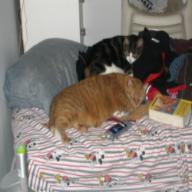What are the reactants and products of CaCO3 ----> CaO + CO2 ? How do you figure that out?
2017-04-25 11:17 pm
回答 (6)
2017-04-25 11:54 pm
In an equation, the reactants are on the left hand side of the arrow, while the products on the right.
Hence, the reactant is CaCO₃, and the products are CaO and CO₂.
Hence, the reactant is CaCO₃, and the products are CaO and CO₂.
2017-04-26 6:40 am
The arrow points away from the reactant(s) and toward the product(s).
2017-05-27 2:02 pm
The arrow points away from the reactant(s) and toward the product(s).
2017-05-24 4:30 pm
The arrow points away from the reactant(s) and toward the product(s).
2017-04-26 1:22 am
It is also quite common to use an = (equals sign) rather than an arrow when presenting reactions. The difference is usually one of indicating whether the process is unidirectional (use an arrow), or an equilibrium (equals sign).
The basic rule of writing a reaction is that the reactants are placed on the left side of the arrow/equals sign, and the products are placed on the right side.
Everything left of that arrow is supposed to be a reactant, and everything to the right is supposed to be a product.
It is usually not "normal" or acceptable to include things in the equation which do not actually change (like we do not include water except if some water is produced or consumed by the reaction, even when the reaction takes place in water).
So, calcium carbonate is the reactant, and the products are calcium oxide and carbon dioxide in your example.
You could easily write the reaction in the reverse direction (CaO+CO2=>CaCO3), in which case the rules state that CaO and CO2 are the reactants, and CaCO3 is the product.
The basic rule of writing a reaction is that the reactants are placed on the left side of the arrow/equals sign, and the products are placed on the right side.
Everything left of that arrow is supposed to be a reactant, and everything to the right is supposed to be a product.
It is usually not "normal" or acceptable to include things in the equation which do not actually change (like we do not include water except if some water is produced or consumed by the reaction, even when the reaction takes place in water).
So, calcium carbonate is the reactant, and the products are calcium oxide and carbon dioxide in your example.
You could easily write the reaction in the reverse direction (CaO+CO2=>CaCO3), in which case the rules state that CaO and CO2 are the reactants, and CaCO3 is the product.
2017-04-26 12:33 am
Reactant(s) is the starting material. In this case 'CaCO3' ( Calcium Carbonate)
The Products are the material that has formed when the reaction has finished . In this case 'CaO' (Calcium Oxide / Lime) and 'CO2' (Carbon Dioxide).
When writing chemical reaction equations, the Reactants always go on the left hand side of the 'equals'. and the products on the right hand side.
The Products are the material that has formed when the reaction has finished . In this case 'CaO' (Calcium Oxide / Lime) and 'CO2' (Carbon Dioxide).
When writing chemical reaction equations, the Reactants always go on the left hand side of the 'equals'. and the products on the right hand side.
收錄日期: 2021-05-01 13:08:13
原文連結 [永久失效]:
https://hk.answers.yahoo.com/question/index?qid=20170425151756AAa9fvo


